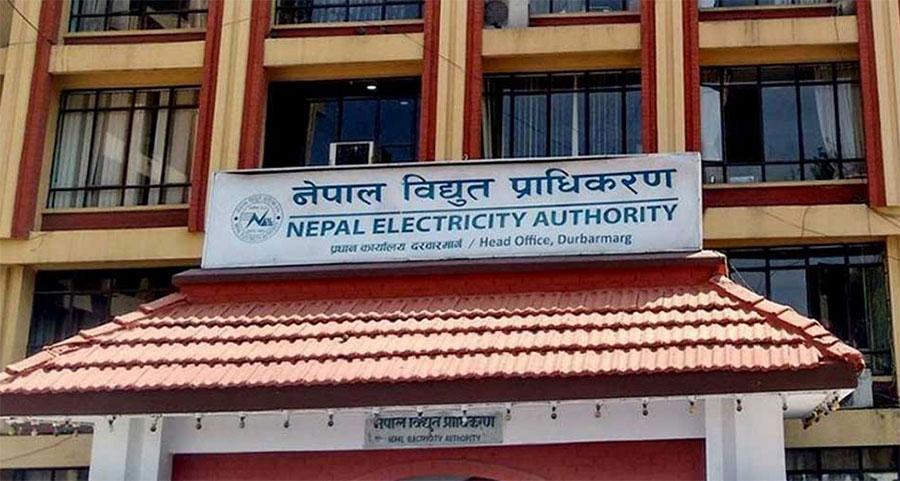Kathmandu, January 19
Customers who are in arrears of electricity tariff will be able to pay in installments. The Nepal Electricity Authority (NEA) has made an arrangement in the Electricity Distribution Regulations, 2078 BS that the blacklisted customers can pay up to 12 installments at a maximum fee as per the rules if they are unable to pay the bill in one lump sum.
If the customer wants to reject the data from the former distribution center and transfer it to another center, it has been facilitated by arranging for re-testing of the electronic materials used at that time.
Emphasis has been laid on reliable electricity service flow by making arrangements for grid
code, construction standards etc. in the regulations.
According to the regulations, people who use electric vehicles will be able to charge their
vehicles by keeping a separate meter in their own house. Customers will be able to charge a vehicle with a large capacity separate meter in their home compound if the vehicle cannot be charged without the approved load for domestic use.
The Nepal Electricity Authority (NEA) has made arrangements to provide meters to the
customers if they demand a separate meter for charging electric vehicles at home through
Electricity Distribution Regulations, 2078 BS. The regulations passed from the 892nd meeting of the NEA Board of Directors on December 7 have been implemented.
NEA Executive Director Kulman Ghising said that the new customer-friendly electricity
distribution regulations have been implemented to provide electricity service quickly, easily and easily and to increase electricity consumption.
”In the past, there was an attempt to ban everything in case of load shedding. Now, with the end of load shedding, it is imperative to increase the consumption of electricity produced in the country. Ghising said, ”We have been reducing electricity tariff to increase consumption. We are also trying our best to make the service customer friendly by facilitating it.”
Through the regulations, NEA has implemented policies for construction and operation of
charging infrastructure for electric vehicles. Permission will be given to the approved body /
firm / person / company to set up public charging stations in private residences, offices, firms / companies / institutions, private and public places, private real estate. Institutions operating public charging stations in major urban areas will be given priority.
In addition, the Government of Nepal, public institutions and the local level will be given
priority if they want to operate a public charging station. Provision has been made to give
approval even if the government wants to set up a public electric vehicle charging station on public land.
Executive Director Ghising said that special arrangements have been made for the promotion of public charging stations through regulations. NEA will provide electricity service including transformers to the service providers setting up charging stations with electricity demand up to 200 KV. In the case of charging stations with higher demand, the work of HT line will be done by the authority but the rest of the work including transformer connection will be done by the service provider, ”he said. A separate electricity tariff has also been introduced for charging stations.
Facilitate drinking water and irrigation
NEA has also provided facilities for milk moistening centers and cold storages run by
cooperatives and drinking water and irrigation operated by cooperatives or communities. NEA will supply power from its own transformer to such customers who are in demand up to 200 KV. Ghising said that such customers will benefit from this facility by reducing the cost of purchasing transformers.
”Previously, customers had to purchase transformers at their own expense if they had to take loads of up to 50 KV and above from NEA’s transformers,” he said. Now, we have tried to provide relief to the customers by removing it and providing power supply to the industries carrying load up to 100 KV from the transformers of the authority, ‘he added. If the load is more than 100 kVA, the customers have to buy the transformer themselves.
Earlier, only 50 percent of the capacity of the available transformer was supplied with
electricity, but now such ceiling has been removed to facilitate the customers.
Line will be cut with tenants for higher tariff collection
The landlord has made an arrangement to cut the line if he collects more than the tariff
specified by NEA from the tenants. The NEA has made arrangements to cut the line of such
households if it is found that they have collected more than the stipulated tariff after the
householder received a complaint from tenants. This will guarantee affordable electricity
services to the rented consumers.
Arrangements have been made for the tenants to get electricity service by keeping a separate meter by fulfilling certain conditions. With such an arrangement, even the consumers living in rented houses will be able to consume affordable electricity services like other customers.
Written consent of the landlord to keep separate meter with commitment to pay the arrears, house renovation agreement made between the landlord and the tenant for at least one year The condition of wiring has to be fulfilled.
Separate meter in the apartment
Arrangements have been made in the regulations to provide electricity service to the
consumers living in apartments, mostly residential buildings, colonies if the specified conditions are met. At present, the apartments have been taking electricity from NEA and supplying it to the occupants at a high cost.
Ghising said that the electricity consumption will increase due to the increase in the use of
electronic equipment as the occupants of the apartment can now get electricity directly from the NEA by taking a meter. Industries with different electricity tariff rates within the same industrial complex will be allowed to have separate meters while operating.
By Karuna Thapa


